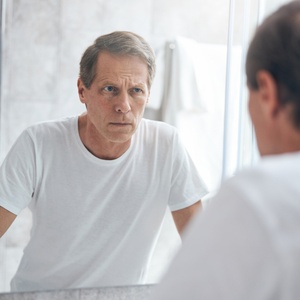Blog
Welcome to FaceForward
Get the scoop on all things beauty, wellness, and skincare.

You aren’t the only one who suffers from a red, flushed face, though that’s little comfort when you’re dealing with a flare-up. According to recent research, approximately 5.46% of the global adult population — or an immense 415 million people — have rosacea.
Rosacea is common and potentially chronic. Like a bad song on repeat, once you have it, it sticks around. And despite how many people are affected, research into precisely how to cure it once and for all is still lacking.
Fortunately, dermatologists have a few go-to solutions that can be effective in easing the obvious symptoms of rosacea so you can take life on without worrying about how to cover up the redness, broken vessels, or bumps.
Rosacea frequently goes unrecognized and undiagnosed, and the kicker is: you can have more than one type of rosacea, and people often do.
The National Rosacea Society has identified and developed criteria for four types of rosacea:
All four rosacea types can range from mild to serious. A mild case is enough to make someone feel self-conscious, while a serious case can create a significant degree of anxiety, and even pain. Fortunately, with treatment, you can get the symptoms of rosacea under control.
How do you know if you have rosacea rather than adult acne or some other skin condition? All four types of rosacea have distinguishing characteristics that set them apart from other skin conditions.
The first sign that you may have this type of rosacea is if the central area of your face has a light to bright red hue. You probably also notice small, red broken blood vessels on your cheeks and the bridge of your nose. If you’re wondering why your face always seems to itch or feel like you washed it in a light acid, it may be a sign that you have rosacea. You may also have dry, scaly and rough skin that's sensitive and sometimes swollen.
With this form, symptoms appear only in the eye area. You may look like you’ve been crying, with watery and itchy eyes. Instead of broken blood vessels on your skin, you find them in your eyes. Your eyes may also feel like you’ve been swimming in an over-chlorinated pool. With ocular rosacea, you may also frequently get cysts. Occasionally, ocular rosacea can lead to blurry vision.
If you have papulopustular rosacea, you get deep red, acne-like bumps that accompany very red and oily skin in the central region of your face. Your skin may also be sensitive, and you likely have broken blood vessels. Another symptom of this form is thickened skin. Your pores can appear enlarged as the skin around them swells.
Thick-looking skin is prevalent with this type of rosacea as well. It occurs primarily on the nose but can also appear on the forehead, chin and cheeks. The nose takes on a bulbous appearance, with enlarged pores and red skin.
Unfortunately, the exact causes of rosacea are as yet unknown. You may be able to blame it on your genes, but it seems environment or lifestyle choices are equally contributive. A study on identical and fraternal twins found that inheritance and environmental factors both contributed to the disease approximately 50% of the time.
Environmental factors found in this research included:
To make things even more complex, people with rosacea are more likely to have an excess of demodex on their skin. Demodex is a mite that naturally lives on human skin. What isn’t known is whether rosacea is the chicken or the egg in this situation.
Two other microscopic biological factors are the presence of an intestinal bacteria known as Helicobacter pylori and too much cathelicidin, a protein that typically protects the skin from infection.
Rosacea frequently appears between the ages of 30 and 50. If you are of Northern European descent and have fair skin, you’re at a higher risk. Women seem to get rosacea more frequently than men, but men have more severe cases. What isn’t quite clear is whether women seek help for the skin condition, and are in turn diagnosed more often than men, or whether it truly affects women more. Likewise, people with darker skin may not notice symptoms in mild cases as readily as people with fair skin.
Your social life isn’t over - there is help for rosacea symptoms. With the right treatment, symptoms can be diminished and your skin can look clear again.
The most effective solutions used by dermatologists are topical applications that reduce swelling and help to calm redness, such as:
Your skin isn’t like anyone else’s, which is why Nava MD treats every patient with a custom plan and the help of a licensed physician. Our specialists can help you get custom prescription topical treatments, if appropriate, from the comfort of home and at affordable prices. Get started with your free consultation today.
This article is intended for informational purposes only and should not be considered medical advice.
Consult a healthcare professional or call a doctor in the case of a medical emergency